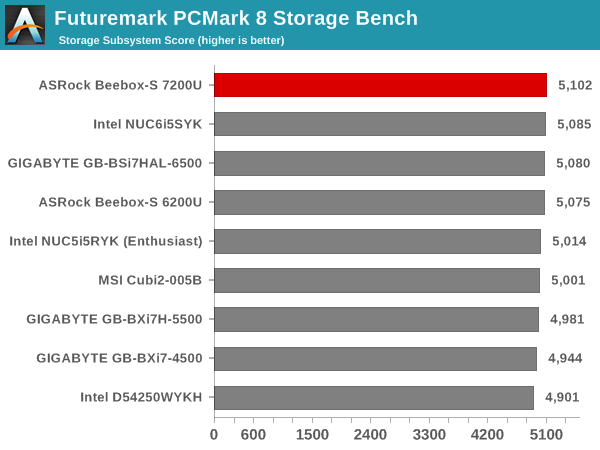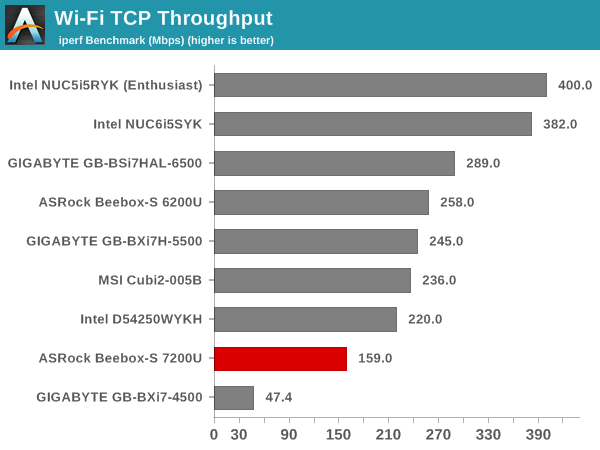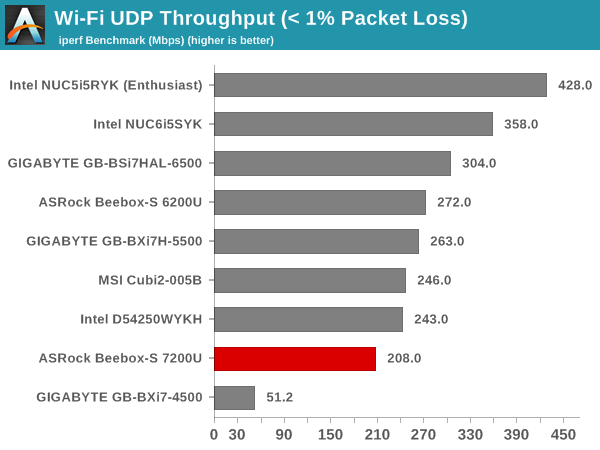ASRock Beebox-S 7200U Kaby Lake UCFF PC Review
by Ganesh T S on February 7, 2017 8:00 AM ESTNetworking and Storage Performance
Networking and storage are two major aspects which influence our experience with any computing system. This section presents results from our evaluation of these aspects in the ASRock Beebox-S 7200U. On the storage side, one option would be repetition of our strenuous SSD review tests on the drive(s) in the PC. Fortunately, to avoid that overkill, PCMark 8 has a storage bench where certain common workloads such as loading games and document processing are replayed on the target drive. Results are presented in two forms, one being a benchmark number and the other, a bandwidth figure. We ran the PCMark 8 storage bench on selected PCs and the results are presented below.


The Samsung SSD 950 PRO PCIe 3.0 x4 NVMe SSD is able to deliver on its full potential when used in the Beebox-S 7200U. The uplink to the SiP is true PCIe 3.0 x4, unlike some of the Skylake-U UCFF PCs.
On the networking side, we restricted ourselves to the evaluation of the WLAN component. Our standard test router is the Netgear R7000 Nighthawk configured with both 2.4 GHz and 5 GHz networks. The router is placed approximately 20 ft. away, separated by a drywall (as in a typical US building). A wired client with an Intel GbE LAN port is connected to the R7000 and serves as one endpoint for iperf evaluation. The PC under test is made to connect to either the 5 GHz (preferred) or 2.4 GHz SSID and iperf tests are conducted for both TCP and UDP transfers. It is ensured that the PC under test is the only wireless client for the Netgear R7000. We evaluate total throughput for up to 32 simultaneous TCP connections using iperf and present the highest number in the graph below.

In the UDP case, we try to transfer data at the highest rate possible for which we get less than 1% packet loss.

Despite sporting the same WLAN adapter as the Beebox-S 6200U, we find that the Wi-Fi performance of the Kaby Lake unit is much worse compared to the Skylake version. Some customer reviews have indicated that swapping the pigtail connections in the WLAN card helps in improving the performance, though we found that out after our benchmarking was completed.










33 Comments
View All Comments
zepi - Tuesday, February 7, 2017 - link
Did you by any chance test HDR playback over HDMI 2.0 connection to HDR 4K TV?lordmocha - Tuesday, February 7, 2017 - link
According to "7th-gen-core-family-desktop-s-processor-lines-datasheet-vol-1.pdf":2.5.8 describes the CPU display support info:
"The HDCP 2.2 keys are integrated into the processor and customers are not required to physically configure or handle the keys. HDCP2.2 for HDMI2.0 is covered by the LSPCON platform device." (The LSPCON is the 3rd party motherboard soldered down solution.)
DP supports HDCP2.2 with HDR (4k@60 10 bit)
HDMI1.4 does supports HDCP2.2 but NO HDR (4k@30 8 bit)
HDMI2.0 does supports HDCP2.2 but NO HDR (4k@60 12bit (YUV 420))
HDMI2.1 does supports HDCP2.2 with HDR (4k@60 12bit (YUV 420))
2.4.3.1 describes the CPU Hardware Accelerated Video Decode support:
HEVC/H265 (8 bit) Profile: Main, Level: 5.1: Max Resolution: 2160p
HEVC/H265 (10 bit) Profile: Main, BT2020, isolate Dec, Level: 5.1, Max Resolution: 2160p
It does not clarify if these are HEVC Version 1 profiles or HEVC Version 2 profiles. It does says "All supported media codecs operate on 8 bpc, YCbCr 4:2:0 video profiles.".
lordmocha - Wednesday, February 8, 2017 - link
Of note is the CPU maxes out at HEVC level 5.1 whereas the HEVC spec goes up to level 6.2, and videos can be found online using levels above 5.1, thus they won't be able to be hardware decoded.vdpauinfo output would be nice to see
star-affinity - Saturday, February 18, 2017 - link
Hmm... Doesn't sound too good – I mean many people (including me) are probably hoping to playback HVEC encoded videos with GPU acceleration on their Kaby Lake computers. So you're saying this won't work with certain HEVC files over a certain level? I'm not deeply knowledgeable how HEVC works – this about levels is new to me.star-affinity - Saturday, February 18, 2017 - link
Sorry HVEC = HEVC there the first time I mentioned it.mikeroch - Monday, February 20, 2017 - link
Wow, it just look great. I believe it will rock and boost the system of http://http-192-168-1-1.net/DanNeely - Tuesday, February 7, 2017 - link
Is it just weird perspective, or is the computer shown on the packaging a much longer model than the one that was reviewed?BrokenCrayons - Tuesday, February 7, 2017 - link
Like all NUC form factor systems, this one is adorably cute! Cooling looks like its done via the internal fan and movement of air so it's a candidate for a collection of kitten stickers on the outside. Those won't hurt internal temps, I'm thinking because of the case being made from plastic.Too bad about the heat issues. It probably won't be a problem under normal use right from the start, but dust buildup might take its toll over time. I do wish companies overbuilt their cooling systems a bit to tolerate fan slowdown and dust.
fanofanand - Wednesday, February 8, 2017 - link
That would blow up the "planned obsolescence" strategy.BrokenCrayons - Wednesday, February 8, 2017 - link
Does a company really need to do something like that with a NUC box? The CPU is soldered down and the motherboards can't be swapped out so the obsolescence is already implied. Designing and installing effective cooling probably would save a company money on in-warranty returns and build goodwill toward the brand by limiting failures and possible erratic behavior.